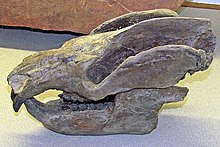Prozostrodontia
| Prozostrodontia Temporal range:
| |
|---|---|

| |
| Skull of Kayentatherium wellesi | |
| Scientific classification | |
| Kingdom: | Animalia |
| Phylum: | Chordata |
| Clade: | Synapsida |
| Clade: | Therapsida |
| Clade: | Cynodontia |
| Clade: | Probainognathia |
| Clade: | Prozostrodontia Liu and Olsen, 2010 |
| Subgroups | |
| |
Prozostrodontia is a clade of cynodonts including mammaliaforms and their closest relatives such as Tritheledontidae and Tritylodontidae. It was erected as a node-based taxon by Liu and Olsen (2010) and defined as the least inclusive clade containing Prozostrodon brasiliensis, Tritylodon langaevus, Pachygenelus monus, and Mus musculus (the house mouse). Prozostrodontia is diagnosed by several characters, including:
- Reduced prefrontal and postorbital bones, with a reduction or disappearance of a strut of bone called the postorbital bar separating the eye socket from the temporal region
- Unconnected dentary bones in the lower jaw
- The presence of a small hole in the skull called the sphenopalatine foramen
- A sagittal crest extending along the top of the skull and connecting with a lambdoidal crest at the back of the skull
- Neural spines of the dorsal vertebrae angled backward
- A convex-shaped iliac crest and a reduced posterior iliac spine on the hip
- An acetabular notch on the ischium (a groove in the hip socket)
- The position of a small projection called the lesser trochanter close to the head of the femur[2]
Prozostrodontia includes tritylodontids, which have traditionally been placed within the more primitive cynodont group Cynognathia as distant mammal relatives. It also includes Tritheledontidae, which has long been placed close to mammals. Most previous studies considered Tritheledontidae a valid monophyletic grouping, meaning it was a true clade including all the descendants of a single common ancestor, but Liu and Olsen (2010) found Tritheledontidae to be a paraphyletic series of basal prozostrodontians. Below is a cladogram from Liu and Olsen (2010) showing the phylogenetic position of Prozostrodontia:[2]
| Cynodontia |
| |||||||||||||||||||||||||||||||||||||||||||||||||||||||||||||||||||||||||||||||||||||||||||||||||||||||||||||||||||||||||||||||||||||||||||||||||||||||||||||||
References[]
- ^ Rowe, Timothy (1988). "Definition, diagnosis, and origin of Mammalia". Journal of Vertebrate Paleontology. 8 (3): 241–264. doi:10.1080/02724634.1988.10011708.
- ^ a b Liu, J.; Olsen, P. (2010). "The Phylogenetic Relationships of Eucynodontia (Amniota: Synapsida)". Journal of Mammalian Evolution. 17 (3): 151. doi:10.1007/s10914-010-9136-8.
- Prozostrodontia
- Extant Late Triassic first appearances







